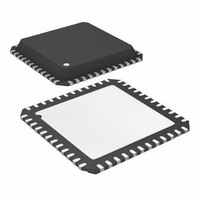ATA6613P-PLQW Atmel, ATA6613P-PLQW Datasheet - Page 37

ATA6613P-PLQW
Manufacturer Part Number
ATA6613P-PLQW
Description
MCU W/LIN TXRX REG WTCHDG 48-QFN
Manufacturer
Atmel
Series
AVR® ATA66 LIN-SBCr
Datasheet
1.ATA6612-EK.pdf
(364 pages)
Specifications of ATA6613P-PLQW
Core Processor
AVR
Core Size
8-Bit
Speed
16MHz
Connectivity
I²C, LIN, SPI, UART/USART
Peripherals
Brown-out Detect/Reset, POR, PWM, WDT
Number Of I /o
23
Program Memory Size
16KB (16K x 8)
Program Memory Type
FLASH
Eeprom Size
512 x 8
Ram Size
1K x 8
Voltage - Supply (vcc/vdd)
2.7 V ~ 5.5 V
Data Converters
A/D 8x10b
Oscillator Type
Internal
Operating Temperature
-40°C ~ 125°C
Package / Case
48-QFN Exposed Pad
Processor Series
ATA6x
Core
AVR8
Data Bus Width
8 bit
Data Ram Size
1 KB
Interface Type
I2C, SPI, USART
Maximum Clock Frequency
16 MHz
Number Of Programmable I/os
23
Number Of Timers
3
Maximum Operating Temperature
+ 125 C
Mounting Style
SMD/SMT
Minimum Operating Temperature
- 40 C
On-chip Adc
10 bit, 8 Channel
Lead Free Status / RoHS Status
Lead free / RoHS Compliant
Available stocks
Company
Part Number
Manufacturer
Quantity
Price
Company:
Part Number:
ATA6613P-PLQW
Manufacturer:
ATMEL
Quantity:
5 000
Part Number:
ATA6613P-PLQW
Manufacturer:
ATMEL/爱特梅尔
Quantity:
20 000
- Current page: 37 of 364
- Download datasheet (7Mb)
6.4.5.1
6.4.6
9111H–AUTO–01/11
Stack Pointer
The X-register, Y-register, and Z-register
Most of the instructions operating on the Register File have direct access to all registers, and
most of them are single cycle instructions.
As shown in
mapping them directly into the first 32 locations of the user Data Space. Although not being
physically implemented as SRAM locations, this memory organization provides great flexibility
in access of the registers, as the X-, Y- and Z-pointer registers can be set to index any register
in the file.
The registers R26..R31 have some added functions to their general purpose usage. These
registers are 16-bit address pointers for indirect addressing of the data space. The three indi-
rect address registers X, Y, and Z are defined as described in
Figure 6-4.
In the different addressing modes these address registers have functions as fixed displace-
ment, automatic increment, and automatic decrement (see the instruction set reference for
details).
The Stack is mainly used for storing temporary data, for storing local variables and for storing
return addresses after interrupts and subroutine calls. The Stack Pointer Register always
points to the top of the Stack. Note that the Stack is implemented as growing from higher
memory locations to lower memory locations. This implies that a Stack PUSH command
decreases the Stack Pointer.
The Stack Pointer points to the data SRAM Stack area where the Subroutine and Interrupt
Stacks are located. This Stack space in the data SRAM must be defined by the program
before any subroutine calls are executed or interrupts are enabled. The Stack Pointer must be
set to point above 0x0100, preferably RAMEND. The Stack Pointer is decremented by one
when data is pushed onto the Stack with the PUSH instruction, and it is decremented by two
when the return address is pushed onto the Stack with subroutine call or interrupt. The Stack
Pointer is incremented by one when data is popped from the Stack with the POP instruction,
and it is incremented by two when data is popped from the Stack with return from subroutine
RET or return from interrupt RETI.
X-register
Y-register
Z-register
Figure 6-3 on page
The X-, Y-, and Z-registers
15
7
R27 (0x1B)
15
7
R29 (0x1D)
15
7
R31 (0x1F)
36, each register is also assigned a data memory address,
YH
ZH
XH
Atmel ATA6612/ATA6613
0
0
0
YL
7
R28 (0x1C)
ZL
7
R30 (0x1E)
XL
7
R26 (0x1A)
Figure
6-4.
37
0
0
0
0
0
0
Related parts for ATA6613P-PLQW
Image
Part Number
Description
Manufacturer
Datasheet
Request
R

Part Number:
Description:
MCU W/LIN TXRX REG WTCHDG 48-QFN
Manufacturer:
Atmel
Datasheet:

Part Number:
Description:
Ata6613
Manufacturer:
ATMEL Corporation
Datasheet:

Part Number:
Description:
BOARD DEMO LIN-MCM FOR ATA6613
Manufacturer:
Atmel
Datasheet:

Part Number:
Description:
DEV KIT FOR AVR/AVR32
Manufacturer:
Atmel
Datasheet:

Part Number:
Description:
INTERVAL AND WIPE/WASH WIPER CONTROL IC WITH DELAY
Manufacturer:
ATMEL Corporation
Datasheet:

Part Number:
Description:
Low-Voltage Voice-Switched IC for Hands-Free Operation
Manufacturer:
ATMEL Corporation
Datasheet:

Part Number:
Description:
MONOLITHIC INTEGRATED FEATUREPHONE CIRCUIT
Manufacturer:
ATMEL Corporation
Datasheet:

Part Number:
Description:
AM-FM Receiver IC U4255BM-M
Manufacturer:
ATMEL Corporation
Datasheet:

Part Number:
Description:
Monolithic Integrated Feature Phone Circuit
Manufacturer:
ATMEL Corporation
Datasheet:

Part Number:
Description:
Multistandard Video-IF and Quasi Parallel Sound Processing
Manufacturer:
ATMEL Corporation
Datasheet:

Part Number:
Description:
High-performance EE PLD
Manufacturer:
ATMEL Corporation
Datasheet:

Part Number:
Description:
8-bit Flash Microcontroller
Manufacturer:
ATMEL Corporation
Datasheet:











